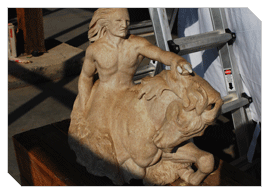

At 563 feet tall, the Crazy Horse Memorial, located in the Black Hills of South Dakota, is the world’s largest mountain carving. The sculpture, which features Lakota war leader Crazy Horse riding into battle, is being carved into a granite mountain just 17 miles southwest of another more famous mountain sculpture, Mount Rushmore.
The carving of the sculpture began in 1948 by sculptor Korczak Ziolkowski, at the behest of Lakota Chief Henry Standing Bear and other Native American leaders. The dream was this: to honor and commemorate Crazy Horse and North American Native Americans by creating a repository for their artifacts, heritage, and culture. The project has since expanded to include a welcome center, as well as a museum which will educate its visitors about North American Native American history.
In order to realize such an immense undertaking, Rich Barry, the current chief engineer at the Crazy Horse Memorial project, contacted Direct Dimensions about a unique challenge. To complete this project, he needed to duplicate many details of the Ziolkowski’s completed miniature Crazy Horse sculpture on a much grander scale. According to Mr. Barry, he had met DDI president and lead engineer Michael Raphael several years ago at the SPAR conference in Houston, an annual summit of leading minds in 3D laser scanning. He knew of DDI’s success at digitizing and replicating small components, and through this partnership, Mr. Barry was able to arrange for the use of a FARO Laser Scan Arm that would enable the smaller sculpture to be precisely reproduced at any size, even a monumental one 563 feet high.
In the summer of 2008, Direct Dimensions engineer Dominic Albanese traveled to the South Dakota site to work on what might be one of the largest scale 3D scanning end products we—and possibly the world—had ever seen. Over the course of three days, Albanese scanned several pieces crucial to the success of the project, including Ziolkowski’s original 2 ½ foot marble sculpture of Crazy Horse, a plaster casting of the sculpture, and a detailed version of the sculpture’s face. In addition, he also scanned a casting taken of Crazy Horse’s actual signature. To capture these details, Albanese used one of the newest and most advanced 3D laser scanners on the market—a portable FARO Quantum Arm paired with the V3 laser line scanner. This scanner provided unparalleled 3D data accuracy without ever having to physically touch the objects being scanned.
While the work proceeded quite smoothly, there was one challenge to overcome. Mr. Barry recalls that one of the marble sculptures was more difficult to scan because the laser from the 3D scanner actually penetrated into the marble surface, creating an uneven and inaccurate digital return. The problem was easily solved, however, by applying a thin coating of Magnaflux—an opaque, talcum-like powder to the statue. This allowed for a more complete and dimensionally-accurate scan. After the scanning was complete, the Magnaflux was easily wiped away.
In the end, an immense amount of data was brought back to Direct Dimensions from South Dakota. Albanese estimates a staggering 20 million data points were taken from his laser scans. Then, using PolyWorks, software program from Innovmetric, the raw scan data was processed and digitally modeled to create watertight polygon files. This format provides a complete, dimensionally accurate 3D model that can aid in the replication of the sculptures, both at mountain-scale and in other smaller formats to create scaled museum quality reproductions. These digital models can also be used to perform a dimensional comparative analysis of the original small sculptures with the work-in-progress mountain carving.
Rich Barry and his colleagues at the Crazy Horse memorial will use the data to make sure that the enlarged sculpture is proportional and finely detailed as it is carved into the mountain. It is a testament to the immense capability of 3D laser scanning technology that through the use of a relatively small laser scanner, a 2-½ foot tall sculpture can be replicated at such a mammoth scale, to be enjoyed by generations to come.